Saturday, May 14, 2005
Silvered Æ antoninianus, Antioch, Rome, Göbl 1626a
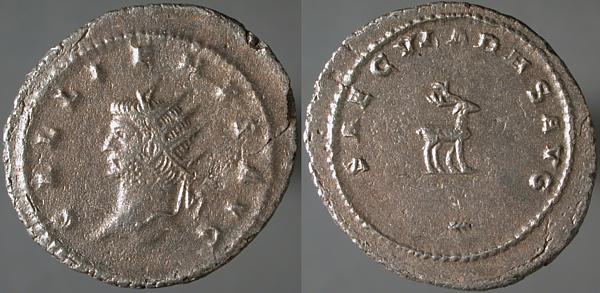
GALLIENVS AVG, Radiate head left | SAECVLARHS AVG, Stag standing right, branch in exergue.
This has been quite the week for critters, eh? While the "zoo series" features animals associated in some way of protective dieties, this coin seems more like the saecular series for Philip the Arab, though it's usually seen with this misspelled reverse legend.
Friday, May 13, 2005
Æ25, Nicomedia in Bithynia, Gallienus, SNG von Aulock 7142...
var (no spear)
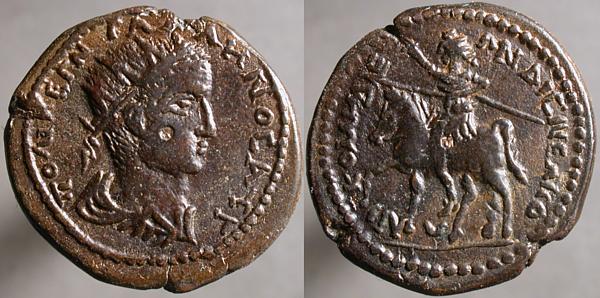
ΠO ΛIK EΓN ΓAΛΛIHNO AYΓ, Radiate draped cuirassed bust right | NI_KOμHΔ_E_ΩN ΔIC NEΩKO_P_Ω, Emperor in military garb, riding left on horseback, his right arm raised before him, spear in his left.
Having a similar coin, also from Nicomedia, with the emperor galloping right only made this one with him riding left that much more desirable.

ΠO ΛIK EΓN ΓAΛΛIHNO AYΓ, Radiate draped cuirassed bust right | NI_KOμHΔ_E_ΩN ΔIC NEΩKO_P_Ω, Emperor in military garb, riding left on horseback, his right arm raised before him, spear in his left.
Having a similar coin, also from Nicomedia, with the emperor galloping right only made this one with him riding left that much more desirable.
Thursday, May 12, 2005
Silvered Æ antoninianus, Gallienus, Rome, Göbl 742b
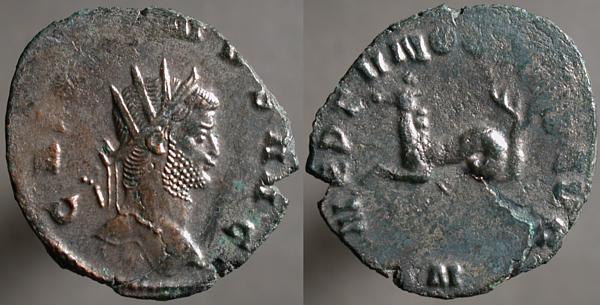
GALLIENVS AVG, Radiate head right | NEPTVNO CONS AVG, Hippocamp swimming left, N in exergue.
Another uncommon example of the "zoo series," this features a hippocamp swimming left, unlike the quite common coins showing it swimming right.
That it's so similar to a common coin, but itself so rare, makes me wonder if the left-swimming dies were engraver's errors, but were too useful to discard. The zoo series coins were probably all minted in a period of a few weeks, with little time for quality control.
Wednesday, May 11, 2005
Dr. Tom Buggey is doing some interesting things on his Ancient Coins site.
AR antoninianus, Philip I, Rome, RIC 15
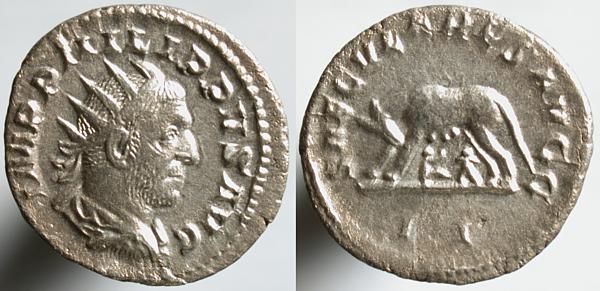
IMP PHILIPPVS AVG, Radiate draped cuirassed bust right | SAECULARES AVGG, She-wolf standing left, suckling Romulus and Remus, II in exergue
Just as Gallienus, for reasons not entirely clear, has the "zoo series", a smaller series of animal reverses was issued for Marcus Julius Philippus, "Philip the Arab", as part of the ceremonies observing the 1,000th anniversary of Rome.
Philip, born a Roman citizen in a village not far from Damascus, reigned 244-249, succeeding Gordian III, for whose death he was at least partly responsible.
While Philip's early career was a military one, his reign saw trouble with the legions, and the usurpers Pacantius, Iotapianus, Silbannacus, and, perhaps, Sponsianus.
By mid-259, the armies of Trajan Decius had rebelled and acclaimed their general as emperor. Combat with the armies of Philip, near Verona, proved fatal for Philip.
Tuesday, May 10, 2005
Æ27, Thessalonica in Macedonia, Gallienus, unknown
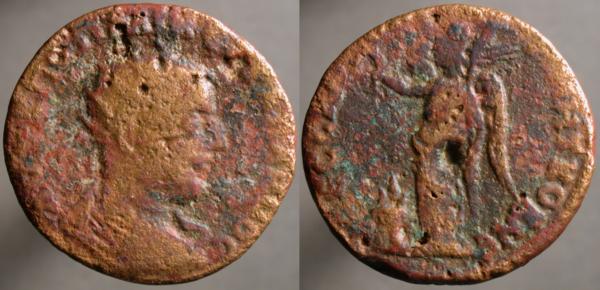
AVT K ΠO ΛIK EΓN ΓAΛΛHNOC, Radiate draped cuirassed bust right | ΘECCAΛONIKH KON B NE, Nike standing facing, head left, holding wreath left and palm over shoulder right. Flaming altar at feet left.
This one clearly suffered during its time in the ground, and the eBay seller didn't attribute it to a city, but enough of the legend is legible to get it. The legend ends BNE, and I knew I'd seen that before. A quick search showed that, even if I can't find a match for the coin, the legend, albeit difficult to read, shows it's from Thessalonica in Macedonia, today Thessaloniki in Greece. I foresee an expensive book purchase (AMNG) in the not-too-distant future.
Monday, May 09, 2005
Silvered Æ antoninianus, Gallienus, Rome, Göbl 730c
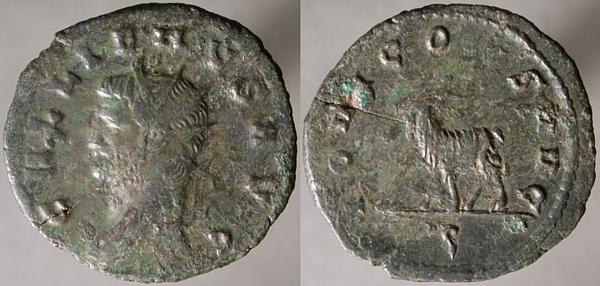
GALLIENVS AVG, Radiate head left | IOVI CONS AVG, Goat standing left. Digamma in exergue.
The only radiate head left that Göbl attests for the entire "zoo series" is a single example of 749c, with the SOLI CONS AVG, Bull standing right, XI in exergue reverse. His plate shows that that example used a different obverse die, with the letters spaced a little differently than this, though the details of the face are so similar that I'm confident both dies were cut by the same hand.
Sunday, May 08, 2005
Æ22, Prusa ad Olympum in Bithynia, Gallienus, SNG Copenhagen 604
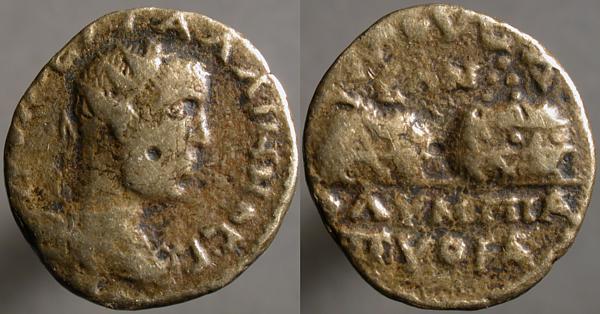
[ΠO ΛI EΓ] ΓAΛΛHNOC C, Radiate draped cuirassed bust right | ΠPOVC / AEΩN, Two prize crowns, each with protruding palm, OΛYMΠIA / ΠYOIA beneath.
Some information on Bursa, Turkey, the site of ancient Prusa.

